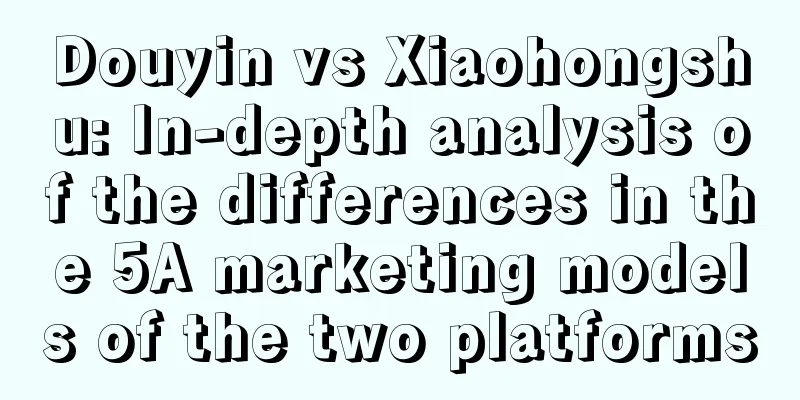10,000 words review | WeChat ecosystem omni-channel marketing, video accounts fill the last link

According to the latest financial report released by Tencent Holdings (00700.HK) on March 20, the WeChat ecosystem continues to develop, with the number of combined monthly active accounts reaching 1.343 billion and the number of daily active users of WeChat search exceeding 100 million. Video accounts have become one of WeChat's new growth points, with the total user usage time doubling. As the WeChat ecosystem becomes more and more sophisticated and prosperous, its commercial value is recognized and valued by more and more brands. How to fully understand and grasp the WeChat ecosystem? How to achieve a closed-loop strategy for omni-channel marketing in the WeChat ecosystem? How to build the WeChat ecosystem into a new engine for brand marketing growth? These are questions that every brand that hopes to achieve growth with the help of the WeChat ecosystem needs to think deeply about. This article will sort out a relatively comprehensive WeChat ecosystem full-domain marketing guide from six aspects: "marketing overview", "strategic planning", "user operation", "people-goods-place matching", "digital growth" and "future outlook". 1. Overview of WeChat Ecosystem Marketing1.1 Development History of WeChat Ecological MarketingExploration period (2012-2015) As the earliest marketing platform, public accounts opened the door to WeChat marketing. Initially, public accounts were mainly used to push information and provide customer service, and their commercial attributes were not obvious. In August 2013, WeChat launched the WeChat payment function. In April 2014, the enterprise account (the predecessor of WeChat Enterprise) was launched. These two functions laid the foundation for the commercialization of WeChat. In January 2015, WeChat launched Moments advertising, and brands began to try to place native ads in Moments. Development period (2016-2018) WeChat has launched a series of commercial tools, creating more possibilities for brands to conduct marketing within the WeChat ecosystem. In January 2017, the mini program was officially launched. The mini program built a lightweight online mall for brands, which can realize online sales, event promotion, member management and other functions. In November of the same year, WeChat launched the "Nearby Mini Programs" to use LBS to attract traffic. The richness and perfection of the mini program enables brands to seamlessly connect with users in marketing links such as customer acquisition, conversion, and retention. At this stage, WeChat ecological marketing entered a diversified development period, and mini programs, social advertising, content marketing, etc. went hand in hand and became the standard configuration of brand digital marketing. Maturity stage (2019-2021) The ideas and methods of WeChat ecosystem marketing are becoming more mature, and many new marketing outlets have emerged. In January 2020, WeChat launched the internal beta of the video account, and short videos began to emerge in the WeChat ecosystem. In early 2020, affected by the mask incident, WeChat video accounts and mini-program live broadcasts became very popular. At the same time, private domain traffic, community marketing, social distribution, etc. have become hot spots for brands to compete for. More and more brands are shifting their marketing focus from public domain traffic to private domain operations, hoping to accumulate their own user assets. In March 2021, two-way binding between video accounts and official accounts will be supported, and a two-way display entrance will be opened, which can be switched between the video account homepage and the official account homepage. The content format of the WeChat ecosystem has been further enriched, and the channels for brands to reach consumers have become more diversified. Transformation period (2022 to present) WeChat has accelerated the pace of innovation in intelligence and video, injecting new vitality into WeChat marketing. In January 2022, WeChat launched the "Open Dialogue Platform" to help companies build intelligent dialogue robots and improve customer service efficiency. In June 2022, WeChat launched new features such as the "Mini Program Live Shopping Cart", providing new possibilities for the development of live e-commerce in the WeChat ecosystem. At the same time, the e-commerce ecosystem of WeChat Video Account is also constantly improving. More and more brands and merchants have settled in Video Account, reaching users through short video seeding and live streaming to achieve sales conversion. WeChat Video Account is becoming an important platform for brands to conduct content e-commerce and private domain operations. Through high-quality short video content and interactive live broadcast experience, brands can better establish emotional connections with fans, thereby improving conversion and repeat purchases. In the future, WeChat Video Account is expected to further leverage its unique advantages of social fission and user sedimentation, form synergy with mini programs, public accounts, etc., and provide more possibilities for brands to grow in the private domain of the WeChat ecosystem. 1.2 Current Status of WeChat Ecosystem MarketingThe WeChat ecosystem covers a series of interconnected marketing platforms and tools, including the following:
It is worth mentioning that the sales of live streaming products on Video Account surged more than 8 times year-on-year in 2022, and maintained a strong growth momentum in 2023, with the total user usage time doubling. In 2023, the overall sales of Video Account and Mini Programs exceeded 100 billion yuan. Tencent hopes to achieve sustained and healthy growth in Video Account e-commerce revenue by improving the shopping experience of Video Account and strengthening integration with Mini Programs. 1.3 Core Value of WeChat Ecosystem MarketingAs the mobile application with the largest user scale and the highest frequency of use in China, it has become a key position in digital marketing. The large and active user base provides brands with huge reach and sales conversion opportunities. The unique value of WeChat ecological marketing lies in that it opens up a direct connection between brands and users, providing an ecological closed loop that integrates social, information, services, entertainment, business and other functions. In this ecosystem, brands can achieve marketing goals such as brand exposure, content dissemination, user management, transaction conversion, and customer service through various forms such as official accounts, mini-programs, video accounts, corporate WeChat, and WeChat payment. In particular, the social attributes of WeChat give brands the opportunity to embed marketing into users' social networks and achieve fission dissemination and transaction conversion by leveraging users' social relationship chains. Five core values:
2. Strategic Planning of WeChat Ecosystem Marketing2.1 Brand positioning and tonality designFirst, we need to clarify the brand’s unique value proposition and design a communication tone that fits the WeChat ecosystem around this proposition. Specifically, we need to do the following: Insight into target users and clarify brand positioning We need to deeply analyze the target users’ gender, age, occupation, income, hobbies, consumption habits and other characteristics to understand their behavioral characteristics and content preferences in the WeChat ecosystem. On this basis, we can refine the brand’s core selling points and unique value propositions to establish a differentiated positioning in the minds of target users. For example, the target users of a new beauty brand are Z-generation women who pursue individual self-expression and like to show off their creative makeup on WeChat Moments. The brand can position itself around the proposition of "releasing the true color of me" and convey the brand value of encouraging self-expression. Design in line with the brand tone of WeChat ecosystem Based on brand positioning, we need to further design a brand tone that fits the WeChat ecosystem. The WeChat ecosystem emphasizes interpersonal communication, and users want to see real, interesting, and warm content. Therefore, the brand tone should highlight affinity and interaction, and close the distance with users through sincere, humorous, and personalized language. In terms of visual design, it is necessary to take into account both aesthetics and functionality, so that elements such as layout, color, and images can not only convey the brand tone, but also adapt to the browsing habits of mobile terminals such as WeChat, and enhance the user experience. In addition, it is necessary to pay attention to popular content forms in the WeChat ecosystem such as emojis and long pictures, and take advantage of them to spread. In terms of brand personalization and differentiation, we need to deeply understand the values and aesthetic preferences of target users and extract a unique brand tone that is different from competing products. We can analyze users' online and offline behaviors, explore their preferences in content, interaction, purchase, etc., and transform them into the style genes of brand communication. We need to let the brand tone penetrate into multiple dimensions such as vision, copywriting, and audio to create a brand personality that users will never forget. Ensure brand consistency across all channels The WeChat ecosystem includes multiple channels such as official accounts, video accounts, mini-programs, and Moments ads. Each channel has a specific communication context and user psychology. It is recommended that brands first sort out the tonality benchmarks of each channel, then extract a unified brand tone, and then break it down and implement it in the communication scenarios of each channel to ensure consistent tonality. For example, in the relatively formal content platform of public accounts, the brand tone can be more professional and authoritative; in social scenarios such as video accounts and Moments, the brand tone should be more down-to-earth and more immersive. Mini programs can convey brand tone through personalized services. Continuously iterate and optimize with user insights The WeChat ecosystem is changing rapidly, and user needs are constantly upgrading. Brands need to establish a regular user research mechanism to continuously gain insight into target users’ feedback and pain points, and dynamically optimize brand positioning and tone. You can take advantage of the interactive nature of the WeChat ecosystem to maintain communication with users through questionnaires, topic discussions, private message conversations, etc., to understand their true opinions on brand content and activities, and to find room for optimization in brand tone. In general, brand positioning and tonality design is a systematic project that needs to be based on solid user insights, balance brand USP and WeChat ecological attributes, and focus on consistency across channels. Appropriate brand positioning and tonality can help improve brand awareness and reputation, laying a good foundation for marketing conversion. 2.2 Marketing Goal and KPI SettingTo do marketing in the WeChat ecosystem, you need to set phased, quantifiable goals based on the brand development stage and marketing budget, and match them to various marketing channels and delivery scenarios. Specifically, you need to do the following: Prioritize marketing goals At different stages of brand development, the focus of marketing goals will be different. Start-up brands may focus more on improving brand awareness, growth brands may focus more on sales conversion, and mature brands may focus on improving user loyalty and repurchase rate. Therefore, we should prioritize the marketing goals of each stage according to the development stage of the brand and the size of the marketing budget. We should avoid being greedy and wanting everything, but focus resources on creating hot spots and achieving breakthroughs with focus and rhythm. Marketing goals are broken down into KPIs for each channel WeChat ecosystem marketing usually involves multiple channels such as official accounts, Moments ads, mini-programs, video accounts, etc. Each channel has different positioning and advantages, and the corresponding KPI indicators should also be emphasized. Taking the official account as an example, the KPI can be the number of readings, the number of views/comments/forwards, the number of new followers, etc.; the KPI of Moments ads can be the number of people reached, click-through rate, conversion rate, etc.; mini programs can focus on data such as visits, activity, retention rate, and transaction volume; video accounts should pay attention to indicators such as playback volume, interaction volume, and fan growth. When setting the KPI for each channel, on the one hand, it is necessary to reflect the characteristics of the channel, and on the other hand, it is necessary to match the overall marketing goals, break down the macro goals layer by layer, and implement them in each channel and delivery scenario. KPI setting should be based on industry benchmarks In order to make KPI indicators more operational and challenging, we must fully draw on industry benchmark data, evaluate the brand's historical performance, and estimate growth space. You can select benchmark brands in the industry as benchmark objects, study their data performance in various marketing channels in the WeChat ecosystem, and understand the benchmark level of KPI indicators. Then, consider the brand's own resource endowment, marketing budget and other factors, and set challenging but achievable KPI indicators. For example, the benchmark value of the playback volume of a beauty brand’s WeChat video account is the average level of the industry’s top 10. Based on this and taking actual conditions into consideration, the brand can set a KPI target of 20% month-on-month or year-on-year growth. Establish KPI monitoring mechanism The setting of KPI indicators is not achieved overnight, but a dynamic optimization process. It is necessary to establish a normalized KPI monitoring mechanism, use data sources such as WeChat advertising background and third-party monitoring tools, and follow up the completion of KPIs of various channels in real time. For KPIs that are difficult to achieve in the short term, we need to analyze the reasons in a timely manner, optimize marketing strategies, and adjust resource allocation. For KPIs that have already been achieved, we need to review and summarize the experience, and appropriately increase the subsequent target values to motivate the team to continue to innovate and make breakthroughs. In short, setting marketing goals and KPIs is a goal-oriented, data-guided scientific process. It is necessary to base on the brand development stage, learn from industry benchmarks, refine to each channel scenario, and follow the "setting-monitoring-optimization-review" workflow. 2.3 Resource integration and investment planningWeChat ecosystem marketing requires multi-dimensional resource investment, including traffic resources, content resources, data resources, talent resources, etc. Scientific resource integration and investment planning can make marketing activities more effective. Specifically, the following points should be done well: Comprehensive inventory of brand resources First, we need to comprehensively sort out the brand’s resource endowments in the WeChat ecosystem, including the existing official account matrix, historical content library, user data, marketing budget, execution team, etc., and evaluate the scale and quality of existing resources. On this basis, re-examine the brand's marketing goals and marketing strategies, analyze possible gaps in resource supply, and formulate targeted resource acquisition and optimization plans. For example, if a brand’s own traffic resources are insufficient, it can consider introducing external traffic through KOL cooperation, mutual promotion, etc.; if the original content reserves are insufficient, it can hire a professional content team or MCN agency to provide support; if the user data accumulation is limited, it can take advantage of the social relationship chain advantages of the WeChat ecosystem to encourage users to actively improve their information and improve data quality. Optimize resource allocation based on marketing goals After taking inventory of resource endowments, we need to further optimize resource allocation, use limited resources where they are needed most, and focus on supporting channels and scenarios that can effectively promote the achievement of marketing goals. Taking the public and private traffic of the WeChat ecosystem as an example, if the brand is in the start-up phase and the marketing goal is to increase brand awareness, then more resources can be invested in public traffic channels such as official accounts and WeChat Moments ads to leverage larger-scale exposure. If the brand develops to the growth stage and the marketing goal is to increase user conversion rate, it should increase investment in the operation of private traffic and achieve in-depth user operations through mini programs, corporate WeChat and other platforms. Constructing multiple paths for resource acquisition Brands’ own marketing resources are usually limited, so they need to expand multiple channels for resource acquisition and innovate ways and methods of resource integration. In addition to conventional budgetary investment, the following approaches can also be considered:
Long-term investment in core resources When doing marketing in the WeChat ecosystem, some core resources require brands to invest in a long-term and continuous manner to form exclusive barriers. Content resources are one of them. High-quality content is the key to attracting and retaining users, but content production has its own rules and it is difficult to achieve it overnight. Brands need to allocate content production resources in a targeted manner, including a full-time content team, a stable content production mechanism, and appropriate content incentives. Marketing innovation in the WeChat ecosystem requires the support of a "1+N" compound talent team. The core is comprehensive management talents who understand marketing, and the periphery is professionals who master vertical fields such as content, live broadcasting, community, short video, and data. We should attach importance to the introduction and training of diversified marketing talents and build a talent team with complementary skills and efficient collaboration. We can absorb excellent marketing talents in the industry through a combination of internal training and external introduction, and give them greater room for growth and freedom of innovation. In addition, the accumulation of data resources also requires a long process. It is necessary to establish a unified data management platform, standardize and structure user data, continuously enrich user tags, optimize user portraits, and provide data support for marketing strategy optimization. In general, resource integration and investment planning need to be "targeted, synergistic, and sustained". Based on brand marketing goals, existing resources should be activated, incremental resources should be developed, and long-term investment should be made in key resources. Only by laying a solid resource foundation can brands maintain sustainable competitive advantages in the ever-changing WeChat ecosystem. 2.4 Marketing strategy formulationMarketing strategy is the specific method and path for brands to achieve their marketing goals. It is a key step in transforming early market insights, resource inventory and other links into executable plans. In the WeChat ecosystem, common marketing strategies include content marketing, interactive marketing, social fission, KOL marketing, private domain operations, etc. Brands need to choose the most suitable strategy combination based on their own tone positioning, target audience, resource endowment and other factors. Specifically, the following points should be done well: Develop a content marketing strategy Content marketing is the most basic and commonly used marketing strategy in the WeChat ecosystem. Brands attract the attention of target users, build trust, and ultimately guide user conversions by producing high-quality content. When developing a content marketing strategy, consider the following elements:
For example, a food brand can focus on the theme of "delicious food on the tip of your tongue" by publishing recipe guides on the official account, production tutorials on the video account, and recipe search services on the mini program, thus forming a multi-channel and multi-format content matrix. Design interactive marketing gameplay The most prominent feature of the WeChat ecosystem is its social attributes, so interactive marketing is an essential strategic choice. Brands should make full use of the various interactive gameplays provided by the WeChat ecosystem to mobilize user participation enthusiasm and enhance user stickiness. Common interactive marketing methods include:
In addition, we should also pay attention to the innovation and iteration of interactive mechanisms and follow up on the product updates of the WeChat ecosystem. For example, WeChat recently launched new interactive functions such as "dialogue voting" and "rewarded Q&A", and brands should actively try them out to seize new traffic entrances. Activate the social fission effect The most unique advantage of the WeChat ecosystem is the fission propagation based on the social relationship chain of acquaintances. Brands should be good at taking advantage of this feature and encourage users to actively share with their friends by setting interesting and valuable fission incentives to achieve viral propagation. Common social fission gameplay includes:
When designing fission activities, it is important to balance the user participation threshold and the attractiveness of the fission incentives, so that users can actively spread the content with "heart-thrilling and willingness". Leverage KOL marketing voice KOL marketing is one of the most commonly used marketing strategies for brands in recent years. By cooperating with KOLs such as celebrities, Internet celebrities, and industry influencers, brands can quickly reach the KOLs’ massive fans and quickly accumulate brand recognition. When choosing a KOL, brands should focus on the following dimensions:
In addition, brands should attach importance to in-depth binding with high-quality KOLs, and not be satisfied with one-time cooperation, but to establish long-term friendly partnerships. They can consider jointly customizing products with high-quality KOLs, creating exclusive IPs, and deepening the binding of interests between the two parties. Do a good job in private domain traffic operation Compared with the wild growth of public domain traffic, private domain traffic has higher quality and a shorter conversion path, and is the core asset of the brand. Brands should attach great importance to the acquisition and operation of private domain traffic. When operating private domain traffic, we must follow the principles of personalization and differentiation. We must conduct refined operations based on user tags, provide differentiated services for users in different life cycles, and maximize the repurchase rate and life cycle value. In summary, marketing strategy formulation is a systematic project that requires combined innovation in multiple dimensions such as content, interaction, fission, KOL, and private domain, and continuous iteration as the environment changes. Based on marketing goals, it is necessary to balance resource investment, build a strategy combination that matches the tone of the target population, and leverage the traffic dividend of the WeChat ecosystem. At the same time, it is necessary to pay attention to the review and optimization of strategies, stop losses in time, and continuously accumulate marketing experience and data insights. 3. Global User Operation of WeChat Ecosystem MarketingThe core of global user operation is to achieve the coordinated conversion of public domain traffic and private domain traffic, and ultimately establish a global membership system for the brand. The introduction of public domain traffic is the first step in global user operation, and the purpose is to introduce massive users into the brand's private domain pool through various marketing methods. 3.1 Introduction of public domain traffic outside the ecosystem
3.2 Introduction of public domain traffic within the ecosystemAdvertising in WeChat Moments: Brands can use WeChat Moments advertising to reach users accurately, and target advertising based on user portraits, directing advertising ideas and landing pages to brand mini-programs or adding micro-traffic. Pay attention to the timing and frequency of advertising to avoid causing user disgust.
Public account graphic promotion: Publish high-quality content on the public account and set up user interaction paths, such as reading the original text, QR codes in the text, etc., to encourage users to enter the mini program, add corporate WeChat, etc. The content should have a certain degree of appeal to attract users.
Mini Program Sharing Fission: Through the sharing and invitation mechanism within the Mini Program, users are encouraged to actively share the Mini Program with their WeChat friends and WeChat groups, guiding more users to enter the Mini Program. Some incentives can be used to stimulate user fission, such as cash red envelopes, coupons, etc.
Video account content seeding: Take advantage of the short video feature of the video account to output interesting and useful product videos to attract users’ attention and then guide them to the mini program or official account. Pay attention to labeling videos to increase exposure. You can also try video account live broadcasting to enhance real-time interaction and conversion with fans.
3.3 WeChat Private Domain User OperationAfter introducing public domain traffic, it is necessary to ensure the continuous operation of private domain users, including strengthening user interaction, improving user activity, extending user life cycle, increasing user repurchase rate, etc., to maximize user value. Official account fan management: regularly push high-quality content on official accounts to maintain user stickiness. Personalize and accurately reach different user tags. Guide users to interact, such as likes, comments, and reposts. Use the menu bar to set up quick entry points to facilitate users to enter mini programs or private domain groups.
Interactive social networking on video accounts: Continuously output valuable and resonant short video content through video accounts to strengthen brand awareness. Encourage users to comment and interact under videos to enhance mutual connections. You can also regularly launch interactive topics such as quizzes with prizes and challenges on video accounts to mobilize user participation enthusiasm.
Mini Program Member Operation: With the advantages of high retention rate and high frequency of use of Mini Program, we will focus on member operation. We will improve the member level rights system, provide exclusive discounts and services for different members, and improve member loyalty. We will use the secondary development capabilities of Mini Program to continuously optimize the user experience and increase member activity.
Enterprise WeChat customer management: After adding users as enterprise WeChat friends, you can achieve one-to-one refined operations for customers. Regularly push product information, promotional activities, etc. to users. Record users' consultation, purchase, evaluation and other tracks, deeply understand their needs, and provide personalized services.
WeChat community/group operation: WeChat community is a gathering place for private domain traffic. It is necessary to do a good job in the daily operation of the community/group. Regularly carry out valuable group activities to guide users to discuss and share, and cultivate users' sense of belonging. Identify seed users and use their influence to drive the atmosphere in the group. Develop differentiated operation strategies for different communities/groups.
Connecting the public and private domains: The public and private domains are not separated. It is necessary to connect the public and private domain data, establish a full-domain membership system, and form a closed loop of user operations. Public domain traffic diversion and private domain conversion. Public domain traffic diversion should be aimed at private domain conversion, building a convenient path for users to go from the public domain to the private domain. Clear private domain entrances should be set up in WeChat Moments ads, public account articles, and video account content to minimize user loss.
Private domain activation and public domain voice. The activity of private domain users directly affects the public domain voice. We should do a good job in activating private domain users and encourage them to actively spread brand content and bring public domain voice to the brand. We can use sharing, fission and other mechanisms to enable users to become the brand's tap water.
The global membership system is constructed to connect public and private domain data and build a unified global membership system. Users from different channels can complete identity recognition by connecting accounts and binding mobile phone numbers, so as to realize the interconnection and sharing of global membership rights, points and data.
In short, the public and private domains of the WeChat ecosystem each have their own strengths, and brands should do a good job in top-level design to achieve an organic combination of the two. With the paths of traffic diversion, conversion, activation, and repeat purchase, the funnel optimization of the full-domain user operation can be achieved, and the massive user resources of WeChat can be deposited into the brand's private domain assets to build a solid moat. 4. WeChat Eco-Marketing: Matching People, Goods, and Places4.1 User InsightsUser insights should be based on the WeChat ecosystem, making full use of its global data advantages, and analyzing user characteristics in a multi-dimensional and dynamic manner through the data traces left by users in various contact scenarios such as official accounts, video accounts, mini-programs, communities, and payments. Collect user feedback through high-frequency and accurate interactive channels, conduct in-depth interviews at the front line, and explore the core demands of users. User portrait and behavior analysis Utilize the multi-dimensional data of the WeChat ecosystem to comprehensively portray user portraits:
Analyze user behavior paths and habits within the WeChat ecosystem:
Based on WeChat ecosystem data, users are accurately profiled and clustered:
User demand mining and segmentation Use the WeChat ecosystem to reach users and collect user feedback from multiple dimensions:
Go deep into the WeChat front line and explore the core needs of users:
Based on WeChat ecological data, refined user needs division:
4.2 Product StrategyPopular product creation and product selection strategies
Product experience optimization
Personalized product recommendations
4.3 Content MarketingContent planning and production
Creating and planting grass
Interaction and social communication
In short, content operation should be based on the WeChat ecosystem, based on the content consumption and communication characteristics of WeChat, and create high-quality content that meets user needs and matches the platform's tone. 4.4 Featured LiveLive streaming is already a very mature business. Without further description, we will make some special explanations based on the WeChat ecosystem. In-depth operation of WeChat private domain traffic to achieve accurate live broadcast traffic
Give full play to the "relationship chain" attributes of WeChat live broadcasts and innovate relationship marketing gameplay
Leverage WeChat mini-programs to realize live broadcast scenario-based marketing
Link WeChat Payment points and corporate WeChat to create exclusive live broadcasts for members
Integrate WeChat ecological resources to create an IP live broadcast marketing matrix
The unique value of WeChat live broadcast lies in the deep operation of social relationship chains, the efficient opening of transactions closed loops, and the diversified integration of ecological resources. Brands need to break out of the simple "live streaming" thinking, dig deep into the WeChat ecological opportunities, and achieve linkage innovation at multiple levels such as marketing, membership, and IP. 4.5 Social e-commerceSocial relationship chain discovery
Social distribution and fission
Social asset value conversion
4.6 Online and offline integrationWhether it is owning offline stores or relying on flash events, exhibitions, etc. to carry out offline marketing, brands can focus on consumer experience, break online and offline barriers, and build a marketing system with omnichannel, full scenarios, and full links. Using the WeChat ecosystem as a connector, it realizes online traffic and offline conversion, member connection, rights and interests, experience interaction, sales closed loop, content planting, and scene integration. Offline drainage and online conversion
Online and offline members are connected
Experience interaction and sales conversion closed loop
Combination of content marketing and scenarios
5. Digital empowerment of WeChat ecological marketingThe digitalization of WeChat ecological marketing is a systematic project that requires systematic changes from the perspectives of data, technology, processes, and organization. Enterprises should establish a global data thinking, build a digital and intelligent marketing system, and promote customer-centric agile operations. Through data asset precipitation, data analysis insights, and intelligent application empowerment, marketing will be more accurate, efficient and intelligent, and drive the overall growth of the brand. In addition to leveraging the endogenous data capabilities of the WeChat ecosystem, brands should also focus on connecting user data outside the WeChat domain to achieve full-domain data integration. On the one hand, they should use various data interfaces provided by the WeChat ecosystem to connect users' behavioral data at various touchpoints such as official accounts, mini programs, video accounts, and corporate WeChat. On the other hand, it is also necessary to realize the data docking between the WeChat ecosystem and the brand’s own membership system, CRM system, e-commerce system, etc., and build a unified user data middle platform. Based on the user’s entire domain data analysis, the brand can understand the user’s correlation characteristics in content browsing, social interaction, purchasing behavior, etc., and realize the refined operation of the user’s entire life cycle. 5.1 Customer Data Management
5.2 Data middle platform construction
5.3 Marketing automation
5.4 Intelligent application
5.5 Organizational agility
When formulating marketing strategies and evaluating marketing effects, the effectiveness of each marketing strategy should be evaluated based on the input-output ratio, and the matching degree of resource investment and goals should be weighed. Through a reasonable marketing combination, the budget can be efficiently allocated among various marketing tools, the overall marketing ROI should be improved, and the brand performance growth should be provided strong support. 6. Future prospects of WeChat ecological marketing6.1 Private domain traffic and community operations will become the main battlefield of marketing
6.2 The WeChat ecosystem will accelerate the integration of online and offline
6.3 Short videos, live broadcasts, and social shopping have become new growth points for WeChat ecological marketing
6.4 Full-link digital marketing capabilities become the core competitiveness of the brand
Standing at the new starting point of WeChat ecological marketing, brands must be based on the long-term and look at the future. Technology is rapidly iterating, user needs are constantly changing, and the market environment is undergoing dynamic evolution, which requires brands to maintain an open mind in WeChat ecological marketing and examine the development of marketing from the perspective of innovators. We must dare to break through existing thinking trends, explore new boundaries, new scenarios, and new methods of marketing, and penetrate marketing innovation into every capillary of WeChat ecosystem. Whether it is private domain traffic, social operations, short videos, live broadcasts, social e-commerce, to digital marketing and smart stores, brands need to maintain the courage and spirit of innovation and exploration, and accelerate the transformation of marketing models and value reconstruction. In the future, WeChat ecological marketing will surely move from single-point touch to full-link operation, from extensive management to fine operation, from experience decision-making to digital and intelligent driving, and from online and offline separation to full-domain integration. Only when brands are consumer-centric, technology-supported, data-engine, and innovation-driven, can they truly realize the dimensional reduction and dimensional development of WeChat ecological marketing, build a private domain traffic pool and a digital growth closed loop based on WeChat, and drive the common growth of brand value and user value. WeChat ecological marketing is not isolated, but an important part of the brand's overall digital marketing strategy. In the future, brands should coordinate multiple ecological channels such as WeChat, Douyin, Kuaishou, Taobao, and Xiaohongshu to accelerate the construction of a digital marketing matrix of all-region, full-link, and full-time periods. We should give full play to the unique values of different content forms, user attributes, and marketing mechanisms of different ecology, realize differentiated operations, mutual traffic, data sharing, and member connection, and seek cross-ecology synergy effects. Through the creation of multi-ecology collaboration and the creation of digital and intelligent capabilities in all-region, brands can achieve unbounded expansion of access channels, optimization of user operations experience, agile iteration of marketing decisions, and continuous breakthroughs in business growth. Author: Brand Laobai WeChat official account: Brand Laobai |
<<: How will Harbin Beer respond to the “huge wealth” created by the city’s tourism boom?
>>: Duan Yongping and Jiang Xiaobai: Who understands marketing better?
Recommend
How to print the delivery receipt on Shopee Philippines? What is the method?
It can be said that more and more merchants are op...
What are the international express delivery options? How to choose?
With the advancement of globalization, internation...
Is the PayPal fee high? How is the fee charged?
Paypal is a common credit card payment method for ...
Building a business prediction model is a great method
In data analysis and business decision-making, bui...
The four key words of 618: AI, low prices, refunds only and high return rates
This article mainly discusses the four key words o...
Big models have big price cuts! Byte, Alibaba, Baidu and Tencent take the lead in opening the book!
In the past week, major model manufacturers have a...
Soft advertising volume and reporting anti-funnel are the A and B sides of Xiaohongshu's ecosystem
On Xiaohongshu, a diversified social platform, the...
Debts of hundreds of millions? The Internet celebrity boss behind the "Ice Cream Assassin" pays off his debts through live streaming
Zhong Xue Gao's high prices, marketing methods...
How to register in Wildberries China? What information is required?
Wildberries, as Russia's leading e-commerce pl...
Making a small investment for a big gain, rewarding car owners for good deeds becomes the new marketing secret for car companies?
The brand will give cash rewards or new cars to ca...
Customer experience: Comparison between the experience of Miaoya Camera (AI) and offline photography
This article compares and analyzes the advantages ...
Can you sell fake goods on eBay? What are the risks of making counterfeit goods?
eBay is a global e-commerce platform with a variet...
I no longer believe in buying traffic from outside, but can I count on the video account?
WeChat is gradually shifting more traffic to video...
Analysis of a 10,000-word article: Why do advertising companies want to do consulting? (Part 2)
In the above article, we talked about how the rela...
What are the three types of Amazon sellers?
In addition to different sales models, Amazon also...









